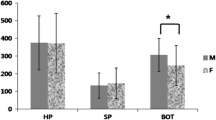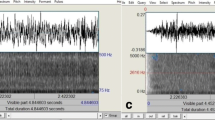Abstract
Soft palate-tongue contact and automatically calculated pharyngeal narrowing ratio (PNR), defined as a ratio between the airway cross-section at the hard palate level and the narrowest cross-section from the hard palate to the epiglottis, could assist in earlier identification of potential obstructive sleep apnea syndrome (OSA) patients even on awake individuals. Parameters were studied on carotid CTA images from 67 consecutively included awake Caucasians who were later classified by second independent physician into the primary snorers (SNORE, n = 34) or obstructive sleep apnea syndrome patient (OSA, n = 33) group according to the clinical examination, laboratory testing and a full-night video polysomnography (PSG) in the sleep laboratory. Imaging and clinical data were statistically compared between groups. The odd’s ratio calculation showed a 2.95 (P = 0.0354) higher risk for OSA development in snoring person with a PNR greater than 8.6. The loose-contact subgroup among OSA patients showed significantly (P = 0.002) higher values of AHI in contrast to the in-contact subgroup.






Similar content being viewed by others
References
Banno K, Kryger MH (2007) Sleep apnea: clinical investigations in humans. Sleep Med 8(4):400–426. doi:10.1016/j.sleep.2007.03.003
American Academy of Sleep Medicine (2005) International classification of sleep disorders: diagnostic and coding manual, 2nd edn. American Academy of Sleep Medicine, Westchester, IL
Young T, Skatrud J, Peppard PE (2004) Risk factors for obstructive sleep apnea in adults. JAMA 291:2013–2016. doi:10.1001/jama.291.16.2013
Peppard PE, Young T, Palta M (2000) Prospective study of the association between sleep-disordered breathing and hypertension. N Engl J Med 342:1378–1384. doi:10.1056/NEJM200005113421901
Ancoli-Israel S, DuHamel ER, Stepnowsky C et al (2003) The relationship between congestive heart failure, sleep apnea, and mortality in older men. Chest 124:1400–1405. doi:10.1378/chest.124.4.1400
Seneviratne U, Puvanendran K (2004) Excessive daytime sleepiness in obstructive sleep apnea: prevalence, severity, and predictors. Sleep Med 5:339–343. doi:10.1016/j.sleep.2004.01.021
Moyer CA, Sonnad SS, Garetz SL et al (2001) Quality of life in obstructive sleep apnea: a systematic review of the literature. Sleep Med 2:477–491. doi:10.1016/S1389-9457(01)00072-7
Young T, Peppard PE, Gottlieb DJ (2002) Epidemiology of obstructive sleep apnea: a population health perspective. Am J Respir Crit Care Med 165(9):1217–1239. doi:10.1164/rccm.2109080
Dreher A, Chau R, Klemens C et al (2005) Correlation between otorhinolaryngologic evaluation and severity of obstructive sleep apnea syndrome in snorers. Arch Otolaryngol Head Neck Surg 131:95–98. doi:10.1001/archotol.131.2.95
Faber CE, Grymer L (2003) Available techniques for objective assessment of upper airway narrowing in snoring and sleep apnea. Sleep Breath 7:77–86. doi:10.1007/s11325-003-0077-9
Schellenberg JB, Maislin G, Schwab RJ (2000) Physical findings and the risk for obstructive sleep apnea: the importance of oropharyngeal structures. Am J Respir Crit Care Med 162:740–748
Rama AN, Tekwani SH, Kushida CA (2002) Sites of obstruction in obstructive sleep apnea. Chest 122:1139–1147. doi:10.1378/chest.122.4.1139
Yu X, Fujimoto K, Urushibata K et al (2003) Cephalometric analysis in obese and nonobese patients with obstructive sleep apnea syndrome. Chest 124:212–218. doi:10.1378/chest.124.1.212
Fajdiga I (2005) Snoring imaging: could Bernoulli explain it all? Chest 128:896–901. doi:10.1378/chest.128.2.896
(1999) Sleep-related breathing disorders in adults: recommendations for syndrome definition and measurement techniques in clinical research. The report of American Academy of Sleep Medicine Task Force. Sleep 22:667–689
Author information
Authors and Affiliations
Corresponding author
Rights and permissions
About this article
Cite this article
Koren, A., Grošelj, L.D. & Fajdiga, I. CT comparison of primary snoring and obstructive sleep apnea syndrome: role of pharyngeal narrowing ratio and soft palate-tongue contact in awake patient. Eur Arch Otorhinolaryngol 266, 727–734 (2009). https://doi.org/10.1007/s00405-008-0800-z
Received:
Accepted:
Published:
Issue Date:
DOI: https://doi.org/10.1007/s00405-008-0800-z




